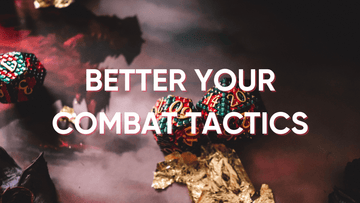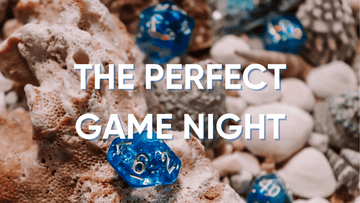Combat is a cornerstone of tabletop role-playing games (TRPGs) such as Dungeons & Dragons. But for some players, navigating a combat senario can feel repetitive or overly mechanical. However, with a little extra thought and strategy, combat can become an exciting and dynamic part of your tabletop role-playing experience. By focusing on teamwork, resource management, and creative decision-making, you can bring more depth to your in-game battles. Here are some tips to level up your combat game.
1. Positioning: Own the Battlefield
Understanding your place on the battlefield can make or break a fight. Where you stand impacts your effectiveness and your team’s overall strategy.
- Cover and Terrain: Use obstacles like walls, rocks, or trees for cover. They can block ranged attacks and provide tactical advantages.
- Flanking: If your DM uses flanking rules, work with melee teammates to surround enemies and gain attack bonuses.
- Spacing: Avoid clustering together, especially against enemies with area-of-effect abilities like fireballs. Spread out to reduce damage.
- Choke Points: Leverage narrow passages or doorways to funnel enemies and limit their movement.
Tip: Visualiae the battlefield like a chessboard—your movements can dictate how the battle plays out.
2. Resource Management: Play the Long Game
Combat in D&D is not just about swinging swords or casting spells—it's about knowing when and how to use your abilities. D&D is a game designed around a party having six to eight encounters a day, this could include both combat and social encounters. While each table is different, you might find your party struggling at the end of a dungeon if you haven't managed your resourecs wisely!
- Spell Slots and Abilities: Don’t burn all your high-level spells or powerful abilities in the first few rounds, or the first combat of the day. Save them for when they’ll have the most impact, like dealing with a boss or turning the tide of a fight. Make use of unlimited resources such as cantrips or normal attacks.
- Items: Don’t forget about potions, scrolls, or magic items. That healing potion could save a downed teammate or yourself in a pinch.
- Hit Points: Think of your HP as a resource. Sometimes it’s worth taking a hit to achieve a critical objective.
Tip: Ask yourself, “Is this the moment to go all out, or can I achieve the same effect with less effort?”

3. Teamwork: The Party That Fights Together, Wins Together
Your party is more than just a group of adventurers—they’re a team. Coordinating your actions can lead to more effective and memorable combats. Take note of your teammates abilities, strengths, and weaknesses. Work together to amplify each other's capabilities.
- Communicate: Share your plans with your teammates. For example, let them know if you’re about to cast a spell that creates difficult terrain so they can adjust their positioning. However, keep in mind each round is six seconds, the second round of combat is not the time for lengthy strategising!
- Set Up Combos: Combine abilities for maximum impact. A wizard casting Web followed by a rogue sneaking in for a critical hit can devastate an enemy.
- Protect Vulnerable Teammates: Shield weaker party members, like squishy spellcasters or injured allies, by positioning yourself between them and the enemy.
- Roles: Embrace your role in the group. Tanks should hold the line, healers should make sure to pick up downed allies, and damage-dealers should focus on taking out high-priority targets.
Tip: Think like a squad, not a solo hero. Coordinated efforts win battles.
4. Creative Thinking: Use the Environment to Your Advantage
Combat isn’t just about the numbers on your character sheet—it’s also about how you interact with the world around you.
- Improvise Weapons or Tools: Push barrels, cut chandeliers, or shove enemies into traps or hazards.
- Control the Battlefield: Use spells like Fog Cloud, Grease, or Entangle to manipulate the terrain and control enemy movement.
- Target Weak Points: Focus on the enemy’s strengths and weaknesses. For example, use fire against trolls or charm magic on a group of low-Wisdom creatures.
- Think Outside the Box: Work with your DM to attempt creative maneuvers. Grappling an enemy to hold them in place or breaking a bridge to slow a pursuing horde can make for memorable moments.
Tip: Always ask yourself, “What can I do besides attack?”
5. Timing: Know When to Strike and When to Hold Back
Timing is crucial in D&D combat. Acting too soon or too late can change the outcome of a fight.
- Wait for Opportunities: Sometimes, the best move is to hold your action or delay your turn. Waiting for an enemy to move into range or for an ally to set up an ability can make your actions more impactful.
- Focus Fire: Work with your team to take out high-priority targets first, such as enemy spellcasters or leaders. If you scatter your attacks too much, it leaves more enemies alive to hurt the party!
- React to the Enemy: Keep an eye on your enemies’ tactics. Are they focusing on your healer? Redirect attention to protect them.
Tip: Don’t rush. Sometimes patience is the key to victory.

6. Learn From Experience: Analyse Your Fights
After each combat, take a moment to reflect on what worked and what didn’t.
-
Questions to Ask:
- - Did I use my resources effectively?
- - Was my positioning optimal?
- - Did I support my team as well as I could have?
- Adjust Your Tactics: Use lessons from past battles to refine your approach. Maybe you need to communicate more, or maybe you realised the value of keeping a spell slot in reserve.
Tip: Every battle is a learning opportunity. Use it to grow as a player.
Final Thoughts
Adding depth to your combat decisions is about more than just winning fights—it’s about making combat engaging, immersive, and fun for everyone at the table. Whether you’re the party’s tank, healer, or damage-dealer, thinking tactically can lead to more rewarding and memorable battles.
So next time you roll initiative, take a moment to step back, assess the battlefield, and ask yourself: How can I make this combat not just successful, but epic? With these tips, you’ll be ready to level up your strategy and make every encounter an adventure. 🎲✨








